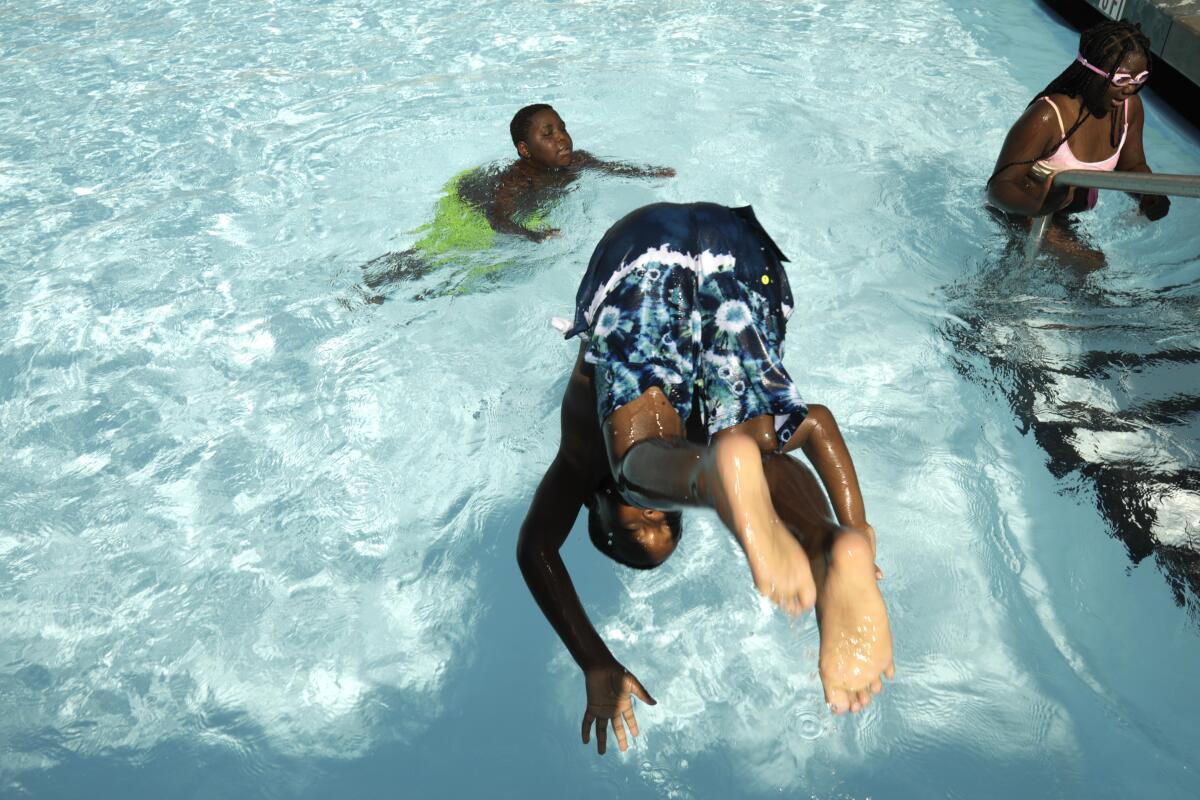8 to 3: Keeping kids water safe this hot vax summer

This is the July 5, 2021, edition of the 8 to 3 newsletter about school, kids and parenting. Like what you’re reading? Sign up to get it in your inbox every Monday.
Tell the truth: You probably went to the pool this weekend.
Maybe your neighbors built an in-ground pool during the pandemic. Or maybe the kidney pool in your apartment complex is finally open again. Maybe you went back to swimming laps at your gym or took your kids to Raging Waters or the newly remodeled Algin Sutton Pool in South L.A.
Whatever your situation, with public, commercial and shared residential pools now fully reopened, and a deluge of new backyard pools built in the last year, chances are good you’ve hit the chlorine since June 15.
In the last two weeks alone, I have been to a splash pad in Las Vegas — don’t ask — two motel pools, a river and three private pools in L.A. (I also took my son to the Pan Pacific Park pool, but we couldn’t swim there because they’d run out of chlorine.)
For a lot of us, water activities just feel safer. After all, most are outdoors, where the coronavirus is hard to spread. And chlorine kills viruses. If you’re anything like me, you probably spent so much time thinking about the Delta variant and COVID-19 precautions this summer that you haven’t given much thought to water safety — that is, drowning prevention. But experts say it’s more crucial than ever this summer.
Now, this is where I typically stop reading. And because I think this information is genuinely new and important, and because I want you to read on, I’m going to make you a promise: There are no upsetting anecdotes in this edition of 8 to 3. I have covered some genuinely horrific child deaths in my time — shootings, stabbings, conflagrations and dismemberments, to name a few — yet drownings remain uniquely haunting to me. I just can’t go there.
What I want to tell you instead is what experts told me about the particular risks present this summer, and how you can mitigate them. As longtime teacher and South L.A. dad Sam Taylor told me while his three youngest children were at swim lessons last week, it’s not like the playground. Accidents can happen silently, in seconds. Kids need your undivided attention in the water.
So here is the most upsetting thing I’m going to tell you: Drowning is the second leading cause of death for kids under 15, after birth defects for the very youngest and car wrecks for those slightly older. It is also significantly more common for poor kids and youth of color, and especially for Black children. What’s more, although pools, beaches and other public waterways were largely closed last summer, drownings actually went up during the pandemic, especially in states such as Texas, Florida, Arizona and California, where backyard pools are common.
“The numbers are speaking to us,” said Torrance Thomas, who founded the water safety nonprofit Tankproof with his twin brother, Thurman. “The numbers are going up because kids don’t have access to quality swim instruction.”
Swim lessons are so important to public health and safety that they were actually classed as essential last year. But because pools weren’t, the vast majority of kids had no access to instruction. Even now, classes are smaller and harder to find, particularly for moms such as Denise Brady, a therapist with two young kids and few daytime hours to spend hunting down lessons or waiting by the pool.
“It’s hard in general to find swimming lessons that are affordable and local,” she told me. “A lot of stuff is during the day, and if you’re a working parent, you can’t just have time off.”
This matters not just for kids like hers and mine who have never had swim lessons, but for those who had them two years ago and have rarely swum since. I saw this in action on Sunday, at a crowded backyard pool party where my friend was shocked to find his 7-year-old, who had once been a strong swimmer, could now barely get across the pool.
“There’s going to be children who swam quite well before the pandemic, and now they might find themselves scared of the water,” said Jared Weston, SwimRight Academy aquatics director at the Westside Jewish Community Center. “As they hit 7 or 8 years old, they start to trim down, they’re not going to float as easily in the water.”
That’s why many experts say one of the most important things parents can do, in addition to basic water safety lessons, is to take their children swimming at pools and beaches with lifeguards on duty. It sounds tautological, but lifeguards really do save lives.
“If we want to make water-based recreation safer, one of the things we need to do is significantly expand access to swim lessons, but the other thing we need to do is significantly expand access to supervised swimming,” said Jeff Wiltse, author of Contested Waters and a leading scholar of swimming and segregation in America.
The good news is that far more safe-swim spots are open this summer than last, and because they’re largely outdoors, most families can feel confident taking unvaccinated children to play there. The not-so-good news is that many public pools aren’t running full hours or capacity, because there are too few certified lifeguards and too little chlorine to operate safely — subjects I’ll be reporting later for our paper.
But that doesn’t mean you should keep your kids from the pool. As Wiltse pointed out to me, pools are a unique source of joy for children. Even the smallest kidney pool can keep my son splashing and playing happily for hours. It’s precisely because pools are so alluring to children, and because they find them so much more delightful than even the most water-loving adult, that parents need to be vigilant this summer, he and other experts said.
Take it from Taylor, father of seven: “You’re in L.A. — you’re gonna be in the water.”
Reflections on racism and Independence Day
Alison Yoshimoto-Towery, the chief academic officer for the Los Angeles Unified School District, has written a personal reflection for this newsletter, inspired by the just-passed holiday. This essay grew out of conversations about the meaning of the Fourth of July in her life, her responsibility for academic services to 465,000 K-12 students and the aftermath of the COVID-19 pandemic.

About 80% of district students come from low-income families, who suffered disproportionately during the pandemic, and about 90% are students of color.
Here is an excerpt from her essay:
Through my own family’s experience, I understand the roots of systemic racism and the need to actively address its long-term effects.
My grandmother was alone in 1942 at Los Angeles County General Hospital when she gave birth to my father. Her husband, my grandfather, and their two toddlers, had been taken by train to an internment camp near Jerome, Ark. Twelve other strong Japanese American women, whose families were also forced to leave them behind, were with her in the hospital. When the 13 babies were born, the infants and their mothers were put on a train and taken to a desolate camp surrounded by barbed wire because the government — our country’s government — feared their ancestry.
My other set of grandparents, mere teenagers, fled from the Manzanar camp to Chicago in 1945. My mother was born just after the war, on Chicago’s South Side. Her first crib was a dresser drawer. It’s where my mom learned that it was safer for American people of Japanese ancestry not to look Asian or speak their parents’ language, but instead to keep their heads down, work hard and stay quiet. How does one not look or act Asian?
You can read the full essay here.
Enjoying this newsletter?
Consider forwarding it to a friend, and support our journalism by becoming a subscriber.
Did you get this newsletter forwarded to you? Sign up here to get it in your inbox every week.
More reports of sexual abuse
Another week, another sexual abuse investigation at an elite boarding school. This time it’s the Cate School in Carpinteria, where law enforcement authorities are looking into reports of misconduct by a former employee. Times reporters Brittny Mejia and Colleen Shalby have the story. The Cate revelations come on the heels of publication of a report about decades of sex abuse and harassment at the Thacher School in Ojai.
I want to hear from you.
Have feedback? Ideas? Questions? Story tips? Email me. And keep in touch on Twitter.
And on a different subject: School is going to look a little different this year for students in the Pomona School District, which has decided to defund the school police. Instead of on-campus patrols by uniformed officers, the district will rely on proctors trained in deescalation methods. Here’s the story from my colleague Melissa Gomez.
Around the state
We’ll be talking for many years about the ways in which the COVID-19 pandemic has altered the lives of children. Here’s another data point to back that up: The number of kids being homeschooled in California appears to have more than doubled in the past year. Of course, virtually all kids were learning from home, but most were doing so under the auspices of their regular school. The question is: How many of the new homeschoolers will stick with it when schools reopen for in-person instruction in the fall. EdSource.
There’s been a lot written about the now-infamous incident last month in which mostly white students from Coronado High School threw tortillas at their rivals from a mostly Latino school. A deeper look at the incident reveals an ugly back story: Last year, Coronado Unified Supt. Karl Mueller promised students he would put his district at the forefront of racial justice — and ran into a buzzsaw of opposition from white parents. San Diego Union-Tribune.
Two leaders of the organization Latinos for Education argue that Latino students were especially hurt by the pandemic and that educators need to come up with plans to get them back up to speed. Hechinger Report.
We’ve reported about how this year’s California budget offers a big boost in education funding. One thing that means: a lot more money for high-needs students, including those with disabilities. CalMatters.
Sign up for Essential California
The most important California stories and recommendations in your inbox every morning.
You may occasionally receive promotional content from the Los Angeles Times.




